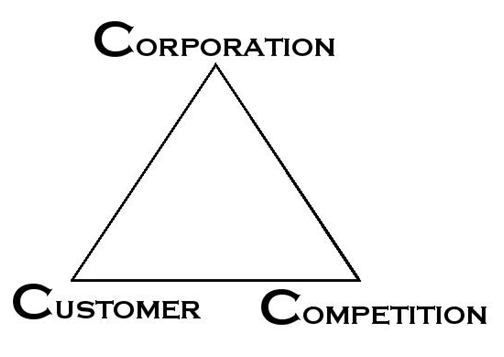Posts by John Dudovskiy

Introduced by Kenichi Ohmae, 3 C’s Model deals with factors that can assist in achieving success for a marketing campaign (Lamb et al., 2011). Namely, 3 C’s stand for corporation, customer and competitors that are known as elements of strategic triangle. Corporation needs effective strategies so that current competitive edge can be further strengthened and additional sources of competitive advantages can be obtained. Specifically, corporate-based strategy involve selectivity and sequencing that involves formulation of competitive advantage, make or buy, that involves reviewing potential for outsourcing some operations, and improving cost effectiveness in relation to various business processes. Customer is seen as the base of any strategy. Accordingly, corporations need to identify their customers clearly by engaging market segmentation on the basis of objectives and customer coverage. Competition can be specified as another important factor. The negative impact of this factor can be minimised through building upon power of the image, capitalising on profit and cost structure differences, and using tangible and intangible resources in a rational way. The practical value of 3 C’s Model relates to identification of important factors effecting marketing strategy and dealing with these factors in an appropriate manner. References Lamb, C.W, Hair, J.F & McDaniel, C. (2011) “Essentials of Marketing” Cengage Learning

Cooks (2008) defines social media as the types of software tools used by individuals in order to consume, convey, create and share content such as blogs, social networking, wikis etc. The literature review revealed a consensus among authors on the idea that during the last decade social media has evolved as an efficient means of communication for business and private purposes. Moreover, Morley and Parker (2010) observe increasing level of addiction to social media among individuals in general, and younger people in particular. Specific characteristics of social media as a communication tools include peripheral traits, facilitation of many-to-many communication, high level of transparency, and many potentials for the disruption of communication. It has been stated that “one of the benefits of using social media services as a communication interface is that a lot of people are already there; they know how to use the features and perhaps the threshold for participating in interaction with others is lower” (Zavoral, 2010, p.413). Additional benefits of using social media as a communication channel in workplaces have been found to include inexpensive or no associated costs (Ruesch and Bateson, 2008), ease of use (Thayer, 2009), possibility to limit visibility whenever necessary (Guffey et al., 2009), and social media serving as a content-sharing medium (Bronstein et al., 2010). According to Bronstein et al. (2010) the use of social media by businesses in general and large multinational corporations in particular is not limited to the facilitation of communication. Rather, social media in its various forms such as company Facebook page or YouTube clip is being valued by increasing numbers of businesses at a strategic level. Moreover, according to Eunson (2012) the introduction of a wide range of innovative social media sites and new platforms for online communication did little to compromise the role of traditional e-mails…

Communication can be effectively defined as “the management of the messages with the objective of creating meaning” (Samovar et al., 2011, p.9). Eight major structural components in communication have been specified by Giffey et al., (2009) as sender, message, channel, receiver, response, feedback, environment, and noise. The role of culture in communications has been stressed by Bronstein (2010), who defines culture as a set of common norms, values and accepted behaviours within the boundaries of a specific group. Specifically, the author convincingly argues that specifications of cultural background of an employee significantly impact the manner in which the employee sends, receives and perceives messages. In other words, content of the message, choice of communication channels and the nature of delivery of communication messages is heavily influenced by specific characteristics of cultural background of the individual who is delivering the communication message. According to concentric model of fields of communication introduced by Eunson (2012) different types of communication can be perceived in an interconnected and systematic way in the following manner: A concentric model of fields of communication Source: Eunson (2012) The model states that the different levels of communication can be interconnected in various ways. Specifically, the concentric model of fields of communication divides communication into six different levels and argues that the more levels of communication are utilised in any particular instance, the better the quality of communication would be. According to Ruesch and Batison (2008) the main barriers to communication include bias, noise, perception, closed-mindedness, and the level of personal stress. However, the main limitation of the article authored by Ruesch and Batison (2008) relates to the fact that the main barriers to communication have been only listed without reflection of the ways in which these barriers have negative implications. Some authors reason that “human communication is largely…

Harmonization is aimed at reducing differences in financial reporting processes around the world. The goal is to achieve some level of comparability in the way financial statements are prepared and presented. When international harmonization occurs, the difficulties for companies and individuals considerably decrease in presenting the financial statements and their interpretations. There are several organizations that have been trying to eliminate the differences between financial reporting standards and achieve international harmonization. If international harmonization is achieved, many countries would benefit from it as it would improve the access to the international financial markets and improve the confidence and knowledge of investors which may even trigger an increase in future investments. As mentioned by Wiley (2000) even if the harmonization is achieved, this will not be fully as there still will be differences in preparation and presentation of financial statements due to reasons such as taxation, culture and the political factors that shape up the accounting standards in any country. Harmonization, as being different from standardization, is the process of creating a similar set of procedures by establishing boundaries as to how much they can differ globally. However, standardization is the process of unifying the reporting standards to make them the same. However, this is almost impossible to achieve. Therefore, harmonization has been implemented considering the facts that even the harmonization can not eliminate the international differences in reporting standards. Garrido, León, and Zorio, 2002 stated that the globalisation has been one of the main drivers of moving towards harmonization by eliminating differences. This has been increasingly important in the case of multinational companies when operating internationally and using different sets of reporting standards which made it less efficient to compare the financial statements. Another importance for harmonization has been an increasing focus on investors as they benefit from new IFRS due…
By John Dudovskiy
Category: Finance

There is a set of problems developing nations facing in world market when trading with industrialised countries: a) Nondiversified economies Many developing nations’ economies are highly dependent on the advanced nations as majority of their exports go to advanced nations and imports come from these advanced nations (Carbaugh 2004) b) Unstable export markets Another characteristic of many developing nations exports are based on primary products (agricultural products, raw materials and fuels) as shown table below. Therefore, when there is a poor harvest or decrease in demand for nation’s specialised product, it can significantly reduce revenues from export and seriously disrupt domestic income and damage employment levels. (Carbaugh 2004). Developing-Nation Dependence on Primary Product 2000 Country Major Export Product Major Export Product as a Percentage of Total Exports Nigeria Oil 96% Saudi Arabia Oil 86 Venezuela Oil 86 Burundi Coffee 79 Mauritania Iron ore 56 Zambia Copper 56 Ethiopia Coffee 54 Chad Cotton 40 Rwanda Coffee 31 Adapted from R. Carbaugh’s “International Economics” (2004, p. 234) c) Worsening terms of trade According to Mankiw (2004) developing nations complain that their commodity terms of trade has declined long time ago, meaning that prices of their exports relative to their imports have fallen. Observers maintain that the export prices of primary products of developing nations determined in competitive market, whereas the monopoly of manufacturers in the industrial nations results in high prices. Furthermore, worsening terms of trade has been used to justify refusal of many developing nations from to attend in trade-liberalisation negotiations (Carbaugh 2004). d) Limited market access. Integration of developing countries as whole into world market has improved significantly. However, protectionism and trade barriers imposed by many advanced nations has been hindrance to developing nations’s market access (Economist.com). Specially, global protectionism in agriculture has been major problem for…

Advantages of specialisation for Developing Countries Increased Production. Developing countries with specialisation are able to gain efficiencies generated from economies of scale and increased output (Mankiw 2004) Production Efficiency. The more efficient use of resources, the higher will be productivity of output of domestic goods and services. Furthermore, international competition leads to use of new technology and marketing methods (Parkin 2008). Benefit to Customers. Parkin (2008) mentions that specialisation in producing limited range of products offer wide range of choice for customers around the world at lower prices as people have tremendous diversity in tastes for different products and they value variety. Arguments against Free Trade and Specialisation. However, Carbaugh (2004) argues that the key to success in free trade can be achieved only through mutually beneficial approach, which satisfies both the giver and taker. Though law of comparative advantage maintains that nations benefit equally from international trade, there might not be mutual benefits between strong and weak countries, as the strong countries tend to take more advantage of it (Mankiw 2004). Many economists believe that current international markets are not level playing field and trade systems in practice favours developed countries and hinder development in the developing or less-developing nations (Carbaugh 2004). They also suggest that organisations such as IMF or WTO mainly work to fulfil interest of powerful countries (Parkin 2008). Another fallacy about free trade is that imports reduce employment, while exports promote growth. Therefore, the notion that import are “bad” while exports are “good” particularly popular among politicians and media (Carbaugh 2004). References Carbaugh (2004) “International Economics”, Ninth Edition, Thomson, New York Mankiw (2004) “Principle of Macroeconomics”, South Western, USA Parkin (2008) “Macroeconomics”, Pearson, USA

Probably there are no any other factor that causes more diversity in accounting than the legal system a country has, as it does not only shape the behaviour of its citizens, but it also prescribes accounting rules and regulates accounting and financial reporting. The degree to which government is involved in standard-setting varies from country to country. Countries that practice common law,such as UK and US have their accounting regulation in the hands of professional organisations with fewer regulations while on the other hand, countries that practice Roman or code law e.g. France and Germany rely on detailed rules that are often included in their company legislation. (Table given below illustrates in which some developed countries’ legal systems fall into this two category.) This leads to less flexibility in the preparation of financial reports and are less likely to justify the accounting treatments as used in common law . Common Law Codified Roman Law England and Wales France Ireland Italy United States Germany Canada Spain Australia Netherlands New Zealand Portugal Japan (commercial) Source: Nobes and Parker (2008) Many studies have showed that “common law” countries tend to be innovative and open to new business ideas, whereas “code law” countries are more likely to follow the formal, written rules and procedures. Further, there seems to be some association of common law countries with particular types of accounting practices. For example, companies operating in common law countries have higher levels of disclosures and tend to report losses quickly (Nobes Parker, 2008). Doupnik and Salter (1995) state that the type of legal system (i.e. code law versus common law) was the main explanation and the basic starting point lied in classifying accounting practices and financial reporting internationally. Another issue that closely related to a country’s legal system is judicial corruption. The…
By John Dudovskiy
Category: Finance

Most people believe that every human being is equal and he/she is entitled to the same rights, privileges and opportunities, regardless their race, gender, faith or age. This fundamental belief changed the way management practices such as the recruitment, training and development of employees are done. In order to fully understand the benefits and disadvantages of multicultural workplace, first of all, the concept of diversity must be fully defined and understood. There are number of definitions for diversity: Diversity is a mix of people of different socially relevant group identities working or living together Diversity means any differences between people Diversity means differences of gender, age, race and ethnic group Diversity is state of being different Therefore, in a nutshell, diversity can be defined as that recognizing, appreciating, valuing and utilising the unique talents and contributions of all individuals regardless of age, career experience, colour, culture, disability, religion, speed of learning etc. Managing diverse workforce can help the company to expand its business and reach to minor communities as they can be able to understand needs of customers from different background. That is to say that diversity is opportunity focused and if managed effectively, it can: Increase productivity Reduce turnover Increase creativity and innovation Increase employee satisfaction Open new markets Further, diversity does not involve any legal requirements or is not implemented just to avoid lawsuits. On contrary, whether to implement diversity is at the discretion of the management. However, managing diverse workforce can be challenge too. If not managed properly, it can cause: Lower productivity Cultural misunderstanding Miscommunication Create conflicts Lack of teamwork

Businesses trading today, including multi-billion multinational corporations have commenced their operations as start-ups and have grown to their current sizes due to a range of reasons, including offering competitive products, and services, engaging in effective marketing exercising strong management etc. Comprehensive study of these success factors is important for new start-ups so that common mistakes can be avoided and chances for success maximised. This article represents a brief critical analysis of the reasons of success and failure of start-ups. The article starts with discussing the major reasons of success and failure for start-ups and this is followed by the illustration of real-life examples in order to justify the opinions. Reasons of success and failure for start-ups There is range of reasons that can make or break start-ups. The level of familiarity and experience of the owner in the relevant industry is a factor that plays a significant role in the future performance of a start-up. In other words, highly successful start-ups tend to have owners that have a high level of experience, and professional and personal interest in the business they are initiating. On the contrary, the majority of start-ups initiated on the basis of the personal interest alone, or for the sake of following a popular trend tend to face significant challenges in various aspects of the business due to the lack or even absence of founder’s experience and knowledge in a given industry. Competitive advantage associated with a business idea is another major factor affecting its success. Competitive advantage is defined by Khosrowpour (2007, p.108) as taken from Braun (2006) as “a condition that enables companies to operate in a more efficient or higher quality manner than the companies it competes with, which results in financial benefits”. Accordingly, start-ups that have stronger competitive edge are more likely…

Defined as “a set of conventional principles and expectations that are considered binding on any person who is a member of a particular group” (Code of Conduct, 2012, online), code of conduct is considered to be an effective tool to encourage or even reinforce particular pattern of behaviour. Code of conduct in health care settings in particular can be described as normative. In other words, they are “concerned with describing what should be done and how you should behave; i.e. the moral principles, rules and values that should guide your actions” (Hendrick, 2004, p.63). This article represents a critical review of a code of professional conduct for nursing and midwifery developed by Nursing and Midwifery Council (NMC) that has been introduced in 2004 and revised in 2008. Revisions relate to the additions of new principles that have increased the total numbers of principles in the code from 54 to 61. The article critically evaluates both, the structure and content of the code and addresses the core principles within the code in a detailed manner. Analysis of NMC Code of Professional Conduct NMC code of conduct is based on four following core principles: The first core principle: taking care of individuals concerned, treating them as individuals, and respecting their dignity at all times. This core principle consists of 20 individual principles that address a range of relevant issues such as treatment of people as individual, respecting of confidentiality of people, maintaining collaboration with those in care, and ensuring that consent has been gained. The principles of treating people as individuals (principles 1 to 4) require nurses and midwife to treat people with great level of care and consideration, not to discriminate against anyone and avoid stereotyping those in care due to their illnesses and possible disabilities. Discrimination can be defined…
January 5, 2013
By John Dudovskiy
Category: Corporate Social Responsibility
Tags: Ethics, Healthcare
